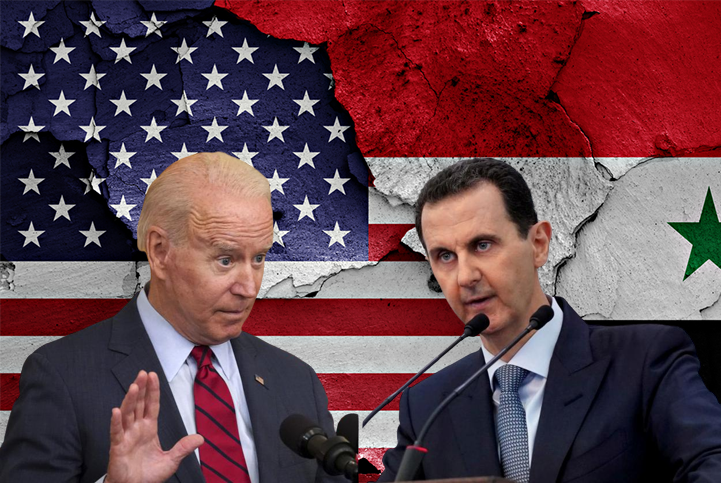The US Secretary of State, Anthony Blinken, stated last week that the US Administration is continuing intensive communications with the neighboring countries of Syria to work for the release of US citizen, Austin Tice, who was kidnapped in August 2012 while covering protests against the Syrian Regime of Bashar Al Assad. The Wall Street Journal affirmed that President Biden had opened negotiations with the Syrian regime to determine the fate of the US journalist, raising many questions about the US Administration’s about-face on Syria. Previously, they had rejected rapprochement with the Arab League and the potential return of Syria.
The State Department announced on May 4th that the US will not resume relations with the Syrian regime of Al Assad and does not support rapprochement until there is real progress on the ground that reflects UN resolution 2254, which calls for free and fair elections under the supervision of the United Nations.
Austin is not the only kidnapped US citizen in Syria; the list includes others, such as the US-Syrian Doctor Magd Kamalmaz, who disappeared after being stopped at a checkpoint of the Syrian regime in Damascus.
Signs that relations are changing:
- Shoring Up the Popularity of the US President Prior to the Elections: With the US presidential elections approaching, President Biden is seeking re-election amidst concerns about his capabilities to carry out the tasks of the presidency given his age. He will be considered the oldest US Presidential Candidate in history. These actions at the moment are an attempt to shore up his popularity among voters by freeing US detainees in states that oppose the US, especially given their success in freeing US basketball star Britney Griner, who was detained for over 10 months in Russia, as well as seven detainees in Venezuela. The presidential envoy for hostage affairs, Roger Carstens, has been exerting tremendous efforts since the time of President Trump, especially when it came to the Wall Street Journal journalist Ivan Gerchekovitch, who was detained by Russian Police Forces and a number of US detainees in Iran, including Syamak Nimazi.
The involvement of the US Administration in the ongoing negotiations with the Syrian regime to free Austin is being taken a step further ever since US military personnel and assets were attacked in Syria by militias loyal to Iran. These militias carried out strikes against the US four times in February and June of 2021, August of 2022, and March of 2023. The US has also intensified its movements to evacuate all US citizens from Sudan after the conflict between the Sudanese Army and the Rapid Support Forces escalated there.
Placing Pressure on the Syrian Regime to Remove the Iranian-Backed Militias: The US still views it as essential that any political settlement in Syria must be tied to the withdrawal of all Iranian and Iranian-backed forces from Syria. The US is also stressing the need to implement Resolution 2254, similar to the efforts carried out in Astana by the Russians and Iranians to improve relations between Turkey and the Syrian regime.
- Relying on Previous Communications: Anthony Blinken’s statement that the US Administration has conducted extensive communications regarding the US journalist Austin Tice is not indicative of a new approach towards the Syrian regime. The Wall Street Journal quoted officials in the Middle East familiar with the US involvement on Austin, that US negotiators held a series of extensive meetings with security officials and politicians in the Syrian government to secure his release.
On August 14, 2020, former US Secretary of State Mike Pompeo announced that former President Donald Trump had sent a personal message to Syrian President Bashar al-Assad in March 2020 proposing direct dialogue in exchange for the release of a US journalist detained in Syria. Two senior Trump administration officials, Kash Patel and Roger Carstens, secretly met with the top Syrian intelligence official to discuss missing US citizens in Syria. At that time, this was the first time a White House official had traveled to Syria. - Adopting the Back Channel Policy: The US adopted a back channel policy, using General Abbas Ibrahim, the Head of the Lebanese Intelligence Agency, to mediate between Syria and the US to secure the release of detained US citizens. General Ibrahim met with Anthony Blinken, the head of the CIA William Burns, and Roger Carstens in May 2022 to mediate the release of the US journalist. He played a crucial role in the release of Canadian tourist Christian Lee Baxter and US citizen Sam Goodwin in 2019.
- The Continued Disagreements Between the US and Syria: Despite the US administration’s insistence that the Assad regime is holding the US journalist, the Syrian government continues to deny the detention. This is a significant obstacle to ongoing negotiations between the US and the regime over the fate of US detainees in Syria and raises the bar for the Syrian regime to ask for the removal of US sanctions against Syria.
A Transformation in US Policy
The numerous direct and indirect attempts made by the US to secure the release of the US journalist detained in Syria represent a transformation in US policy towards the Syrian crisis. Despite opposing US allies’ attempts to strengthen their relations with Syria, the US tacitly approves of these upcoming steps. Deputy US Secretary of State for Middle East Affairs Barbara Liv’s statement on March 9th, “Our main message is if you are going to deal with the Syrian regime then you must get something out of it,” indicates that the US has adopted a double standard in dealing with the Syrian crisis during the current phase.


